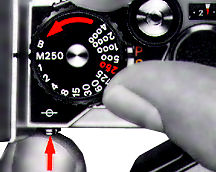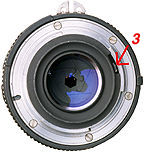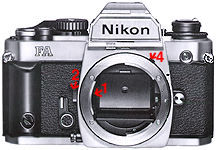M250 and B Settings - You may need to know what can you do with these settings, should one day...Most manual focus Nikon cameras has a very considerate feature in either as back up mechanical lever or shutter speed setting(s). The Nikon FA has two shutter speeds that are not battery dependent in M250 and B (bulb). In the case of the mechanical FM series bodies, battery(ies) are meant only for exposure reading and doesn't relate to camera shutter mechanism.
 |
In the case of FA, these two speeds will not made your light meter activated, even if your battery condition is perfect. Compared with earlier models, both FE-2 and FA use 1/250 sec instead of the conventional 1/90 sec on quite a number of bodies, including the latest FE-10 (Others: FE, EM, FG etc). |
Why 1/250 sec ? It is very
practical to have that speed. Let us assume: Should one day, your battery(ies)
in the camera has drained out or fails to function amidst an photo session,
the 1/250 sec can handle upper end of the shutter speed setting even for
syncro-sunlight photography, while the 'B' can be used for manually timed or
time exposure at the lower speed setting (At 'B', the shutter remains open for
as long as the shutter release button is depressed. B is especially useful for
making long time exposures). The 1/250 sec is quite close to a normal 1/125
sec in which common film speed are used. Both speeds should have allowed a
seasoned SLR users to retain some form of control for manual exposure
calculations based on experience when needs arise.
A locking mechanism
is provided between 1 and M250 on the shutter speed dial. To set either M250
or B, depress the locking button and rotate the dial to either M250 or B.
(Referred to the Reference Map)
Note: At these mechanical settings,
you must depress the shutter release button a little bit more than at other
settings to trip the shutter .With the Soft Shutter Release AR 9 attached, you
cannot release the shutter at these settings.
Before we go on to
the Flash AE/Manual Flash, there is another exposure metering system available
in the FA through mechanical means - the Stopped-Down Metering
method.
Note: But
since this method requires you to understand of how to use the depth of field
lever, you may check the DOF section and get familiarize with the function it
provides before you read this.
Warning: Skip this page if all your current lenses are AI, AIS or AF- type lenses. If you attempt to make a stop-down exposure measurement when an Al-S lens or equivalent mounted directly on the FA, incorrect exposure will result.
Stop-Down Exposure
Mesurement
The
stopped-down metering measurement allows the FA's meter to be used for lenses
that do not couple with the meter coupling lever on the camera (Non-AI and
manual lenses). Please note the FA (FE2 & newer series) has a FIXED
meter coupling lever. Older Nikkors needs to be modified (AI conversion) to be
used in conjunction with the FA. However, due to some of the Nikkor Lenses
like PC Nikkor doesn't has the meter coupling, there can be used in this
stopped down method.
The term 'Stop-Down' sounds very technical or confuse to many new SLR users. What it meant was just close down the iris of the lens to the indicated/selected aperture value that you set in your lens (Often by the Depth of field (DOF) preview lever (2) just next to the lens mount, with the exception of Nikkormat FT series, where their DOF button is at the top panel).
|
|
The illustration shown is with a AI manual focus Nikkor lens, the red arrow (3) is the auto coupling device (You can turn the aperture ring to see the iris open and close, corresonding to your setting). The aperture stop-down lever (1) at the side of the lens mount (Camera Body) will trip your aperture selected on your lens to the exacting value during the exposure. Other times, the lens will stay open to the maximum aperture value of your lens (eg.f.1.4 will be display) to present you with the brightest available lens opening (f1.4 in this case) for easy view, focus and composing. Please note the FE2 (FA & newer series) has a FIXED meter coupling lever (4). |
Note: Illustration used was a AI lens, where details apply to a AI-S and E Series lenses.
Stop-down exposure
measurement must be made whenever the aperture ring of the lens doesn't couple
with the meter coupling lever of the camera. After focusing and switching on
the meter, follow these procedures
You may skip this section if all
your lenses owned are AI, AI-S, Series E or AF Nikkor lenses. But IF you have
a older Nikkor lens that doesn't have a metering coupling ridge or if you are
using a PC (Perspective Control) Nikkor lens or if you are working with some
older extension tubes, bellows or attachments that doesn't have a direct meter
coupling facilities, then the Stopped down metering method should be
used.
In short, Stop-down exposure
measurement must be made whenever the aperture ring of the lens doesn't couple
with the meter coupling lever of the camera. After focusing and switchinq on
the meter, follow these procedures:
For Lenses with Automatic
Diaphragms
In
P, S, or A mode: Push the depth-of-field preview lever all the way down,
manually stop the lens down or open it up to your desired f-number, and trip
the shutter while holding the lever. Note that, with the lever depressed.
metering is automatically switched to centerweighted
In M mode:
Hold down the preview lever and turn the shutter speed dial and/or lens
aperture ring until the LCD shows -+, indicating correct exposure on manual.
Release the preview lever and take the shot.
NOTE: If the depth-of-field
/ever is pushed down in the P or S mode, the shooting mode is automefically
switched to the A mode; also the LCD shows the shutter
speed selected by the camera for the aperture in use . In the S mode, the
shutter speed indication showing the shutter speed set on the dial
does not
disappear.
For Lenses or Accessories Without Automatic Diaphragms
In A mode only: P and S
modes should not be used. Stop the lens down manually until the desired
shutter speed appears in the viewfinder. Then take the picture.
In M
mode: Adjust the shutter speed or aperture until the -+ indication appears
above M.
For Fixed-Aperture Lenses, Photomicrography, or
Astrophotography
In P, S, or A mode: No adjustment of aperture and shutter speed is necessary; just take the picture.
In M mode: Adjust the shutter speed dial until the LCD shows -+, indicating correct exposure on manual. If correct exposure is unobtainable, use an ND (neutral density) filter or electronic flash unit As a last resort, change to a faster or slower film.

